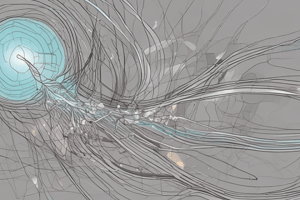Podcast
Questions and Answers
Match the following phases of the action potential with their descriptions:
Match the following phases of the action potential with their descriptions:
Dépolarisation = Pendant laquelle la négativité interne diminue, s'annule et devient positivité (+30 mV) Repolarisation = Pendant laquelle la négativité interne augmente puis revient à sa valeur initiale du PR (-70 mV) Hyperpolarisation = Pendant laquelle la positivité interne diminue, s'annule et devient négativité (-70 mV) Point O = L'artéfait de stimulation, signal de stimulation
Match the following components of the action potential with their descriptions:
Match the following components of the action potential with their descriptions:
OA = Temps de latence au cours duquel le potentiel d'action parcourt la distance qui sépare les deux électrodes S1 et S2 de R1 AB = Phase de dépolarisation pendant laquelle la négativité interne diminue, s'annule et devient positivité (+30 mV) BC = Phase de repolarisation pendant laquelle la positivité interne diminue, s'annule et devient négativité (-70 mV) CD = Phase d'hyperpolarisation pendant laquelle la négativité interne augmente puis revient à sa valeur initiale du PR (-70 mV)
Match the following components of the action potential with their descriptions:
Match the following components of the action potential with their descriptions:
Point O = Signal de stimulation, artéfait de stimulation S1 et S2 = Électrodes pour enregistrer le potentiel d'action R1 = Unité de mesure pour enregistrer le potentiel d'action Oscilloscope = Appareil pour enregistrer le potentiel d'action
Match the following phases of the action potential with their corresponding voltage values:
Match the following phases of the action potential with their corresponding voltage values:
Match the following phases of the action potential with their order of occurrence:
Match the following phases of the action potential with their order of occurrence:
Flashcards are hidden until you start studying
Study Notes
Potentiel d’Action
- Lorsqu'on applique une stimulation d'intensité liminaire ou supraliminaire sur une fibre nerveuse isolée de calmar, on enregistre une variation du potentiel appelée potentiel d'action.
Phases du Potentiel d'Action
- Phase de dépolarisation [AB] : la négativité interne diminue, s'annule et devient positivité (+30 mV).
- Phase de repolarisation [BC] : la positivité interne diminue, s'annule et devient négativité (-70 mV).
- Phase d'hyperpolarisation [CD] : la négativité interne augmente puis revient à sa valeur initiale du potentiel de repos (-70 mV).
Enregistrement du Potentiel d'Action
- Le point O représente l'artéfact de stimulation, c'est-à-dire le signal de stimulation.
- Le temps de latence [OA] correspond au temps pendant lequel le potentiel d'action parcourt la distance qui sépare les deux électrodes S1 et S2 de R1.
Studying That Suits You
Use AI to generate personalized quizzes and flashcards to suit your learning preferences.




